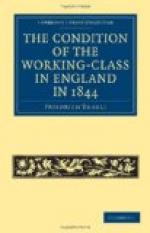and residential quarters than when they hide grimy
working-men’s dwellings; but they suffice to
conceal from the eyes of the wealthy men and women
of strong stomachs and weak nerves the misery and
grime which form the complement of their wealth.
So, for instance, Deansgate, which leads from the
Old Church directly southward, is lined first with
mills and warehouses, then with second-rate shops
and alehouses; farther south, when it leaves the commercial
district, with less inviting shops, which grow dirtier
and more interrupted by beerhouses and gin palaces
the farther one goes, until at the southern end the
appearance of the shops leaves no doubt that workers
and workers only are their customers. So Market
Street running south-east from the Exchange; at first
brilliant shops of the best sort, with counting-houses
or warehouses above; in the continuation, Piccadilly,
immense hotels and warehouses; in the farther continuation,
London Road, in the neighbourhood of the Medlock,
factories, beerhouses, shops for the humbler bourgeoisie
and the working population; and from this point onward,
large gardens and villas of the wealthier merchants
and manufacturers. In this way any one who knows
Manchester can infer the adjoining districts, from
the appearance of the thoroughfare, but one is seldom
in a position to catch from the street a glimpse of
the real labouring districts. I know very well
that this hypocritical plan is more or less common
to all great cities; I know, too, that the retail
dealers are forced by the nature of their business
to take possession of the great highways; I know that
there are more good buildings than bad ones upon such
streets everywhere, and that the value of land is
greater near them than in remoter districts; but at
the same time I have never seen so systematic a shutting
out of the working-class from the thoroughfares, so
tender a concealment of everything which might affront
the eye and the nerves of the bourgeoisie, as in Manchester.
And yet, in other respects, Manchester is less built
according to a plan, after official regulations, is
more an outgrowth of accident, than any other city;
and when I consider in this connection the eager assurances
of the middle-class, that the working-class is doing
famously, I cannot help feeling that the liberal manufacturers,
the “Big Wigs” of Manchester, are not
so innocent after all, in the matter of this sensitive
method of construction.
I may mention just here that the mills almost all adjoin the rivers or the different canals that ramify throughout the city, before I proceed at once to describe the labouring quarters. First of all, there is the old town of Manchester, which lies between the northern boundary of the commercial district and the Irk. Here the streets, even the better ones, are narrow and winding, as Todd Street, Long Millgate, Withy Grove, and Shude Hill, the houses dirty, old, and tumble-down, and the construction of the side streets utterly horrible. Going from the Old




